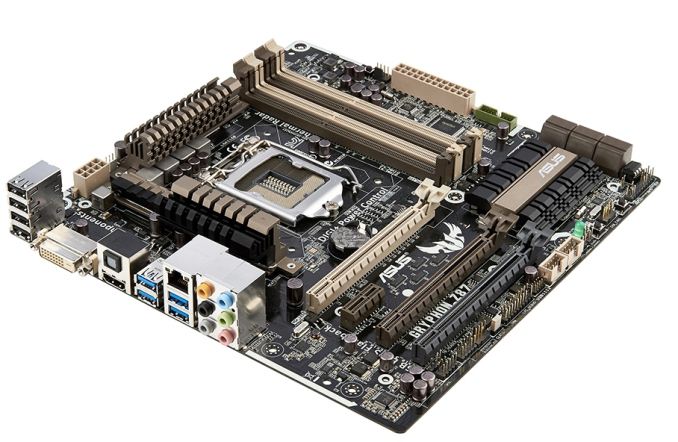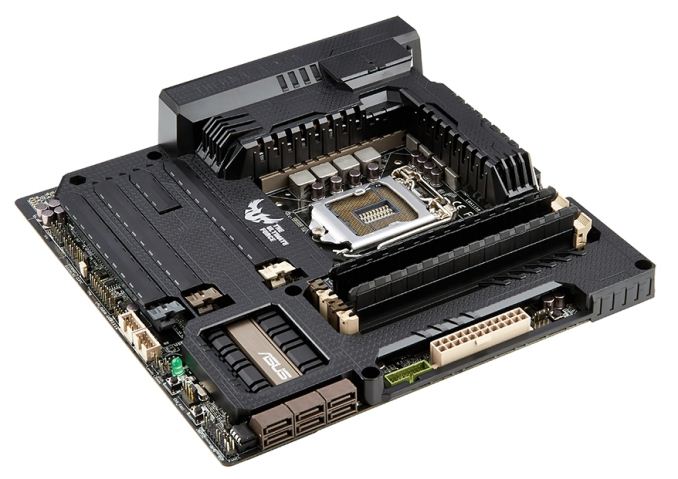ASUS TUF Z87 Gryphon Review
by Ian Cutress on February 3, 2014 10:00 AM EST- Posted in
- Motherboards
- Asus
- Z87
- TUF
ASUS TUF Z87 Gryphon Conclusion
When covering the Z87 Gryphon, or any TUF product, it is hard not to keep mentioning the warranty status. This is what the line is based on after all – a higher rated component, or ones in the higher end of the quality/yield spectrum, in order to provide that extra longevity. This is akin to Samsung making SSD NAND and keeping the best for themselves – the TUF range aim to source whatever components they put on the board from the higher echelons of production.
As a result, the special parts and warranty do come in the form of extra cost. You get what you pay for, right? The Gryphon has a rough time competing against other products in the same price segment for feature set. The Gryphon comes with no extra SATA Controllers, no extra USB 3.0 controllers or hubs, no power/reset buttons, no two digit LED, and so on. This all helps in keeping the component count down on a product (there is less to go wrong), but ultimately this also begs the question of whether a user needs more than six USB 3.0 ports, or more than six SATA 6 Gbps ports. Users can use PCIe cards if they needed more, some would suggest.
If we put the extended warranty and component choice out of our minds for a second, then the Gryphon has several features not on the regular channel market segment. First up is the number of temperature sensors on board. I counted 10, which includes three sensor headers for users to connect to other parts around the case (hard drives, PCIe cards). These tie into the fan control software which allows two point gradient configurations of all six 4-pin fan heads on board, and each fan profile can be tied into a weighted average of any of the sensors. For example, the CPU fans can rely on a profile where the temperature is calculated as 55% the CPU temperature, 35% the DRAM temperature and 10% the GPU temperature.
The Gryphon also offers an additional ‘Fan Overtime’ feature which keeps the fans spinning after the system is shut down in order to allow the equilibration of air inside and outside the case. This can be seen as important in humid climates, where hot air inside the case can cause inside condensation as it cools down. We have seen similar aspects on other motherboards, but this is the first time I have seen it on an ASUS product.
The Gryphon Armor Kit is sold separately to the motherboard and allows the board to be encased in a dust blocker that also forces cooling around the components on the motherboard. The rear plate also helps increase the rigidity of the motherboard due to large GPUs or awkward mounting locations.
While the Z87 Gryphon does not have overclocking as its primary focus, we achieved 4.6 GHz with our CPU sample, in line with many other Z87 motherboards we have tested before. Users looking for an automatic overclock will have to probe in the BIOS some to find them, but we get 4.1 GHz to 4.3 GHz within a few button presses easily. Performance is geared more towards longevity as well, so other motherboards might offer better stock performance too.
The Z87 Gryphon aims to sell on its main features: a five year warranty paired with the micro-ATX form factor. For that it does quite well, and ASUS are filling a well requested hole in their line-up. We have the Sabertooth in to review as well, which may satisfy the need for extra functionality, albeit in a larger size.












62 Comments
View All Comments
HandsomeChow - Wednesday, February 12, 2014 - link
No, the outside ambient air will always be cooler than the air inside the case in this scenario. Since fresh cool air is being pulled into the case and heated up and exhausted out the back. When your computer shuts down, the components don't just suddenly cool down to the ambient. It takes time and gradually the heat energy from the components will be transferred to the air inside the case. But if there is no 'Fan Overtime' the hot air will stay inside the case come into contact with the cold case panel and condense into liquid. But with Fan Overtime, the hot air is exhausted out of the case even after shut down.In more humid climates, the air has a higher % of moisture and therefore would cause a even bigger problem since more condensation will occur inside the computer increasing the probability of a component failure.
HaryHr - Tuesday, February 4, 2014 - link
I bought this board for my brother and after initial windows installation problem it is now working in his system with no problems, stable and more than enough for his needs.The problemwe had was when we first tried to install Windows, installation was failing with "could not configure Windows on this computer’s hardware" error.
It was solved by turning off Fast Boot which is default option.
eanazag - Tuesday, February 4, 2014 - link
I really like the POST testing. I think if you video-ed pressing the power button to Windows prompt, then you could get very accurate and consistent measurements.Tig3RStylus - Wednesday, February 5, 2014 - link
I buy Rampage and Maximus boards, but a friend of mine has bought Sabretooth. One pattern that i noticed is the lack of updates available for Sabretooth line when compared to the plethora of updates for Rampage and Maximus. Not a problem in Year 1 or Year 2, but with the TUF lines focus on longevity of 5 years, i wonder if ASUS will step up their commitment and continue to release updates in year 3, 4 and 5. What updates? things like drivers for controllers are not available for Windows 8 on a Sabretooth board thats 2 years old. My friend is going to be upgrading to either Maximus or Rampage next time and ditching the Sabretooth entirely. I doubt he would go near Gryphon with a bargepole for the same reasons. 5 year warranty is useless for anybody who keeps their software and OS up to date if ASUS dont bother providing updates beyond the bare minimum.rigel84 - Thursday, February 6, 2014 - link
Download the drivers from the manufacturer (Intel, VIA, Realtek and so on). If they provide you with an updated BIOS, their job is done.GTVic - Wednesday, February 5, 2014 - link
I like the complete absence of all legacy ports, including PS/2.YukaKun - Thursday, February 6, 2014 - link
Great Mobo, but just an ALC892? For REAL? At least go for the ALC1150 or a SupremeFX or your own Sonar line for this great MoBo.You dropped the ball there, Asus.
Cheers!
HandsomeChow - Wednesday, February 12, 2014 - link
Just a quicktip, you know the OEM shielding on the SupremeFX is bollocks right? The fact that it is shielded doesn't mean it is not prone to sound interference, if you can see it physically, sound can get to it.DMCalloway - Friday, February 7, 2014 - link
Four days have gone by and still nothing new here........ReneGQ - Thursday, March 13, 2014 - link
I recently purchased an Asus Motherboard and the problems started from day 1. The drivers update never works, the same for AI Suite III (there´s a lot of updates for this model in Asus webpage). After 2 months I still can´t install BitDefender cause a clock watchdog error.Asus technical support is the worst, mails comes and goes with no solution.
I will not recommend this brand to anyone. The brand has a very good Marketing but the product and the service are very disappointment.